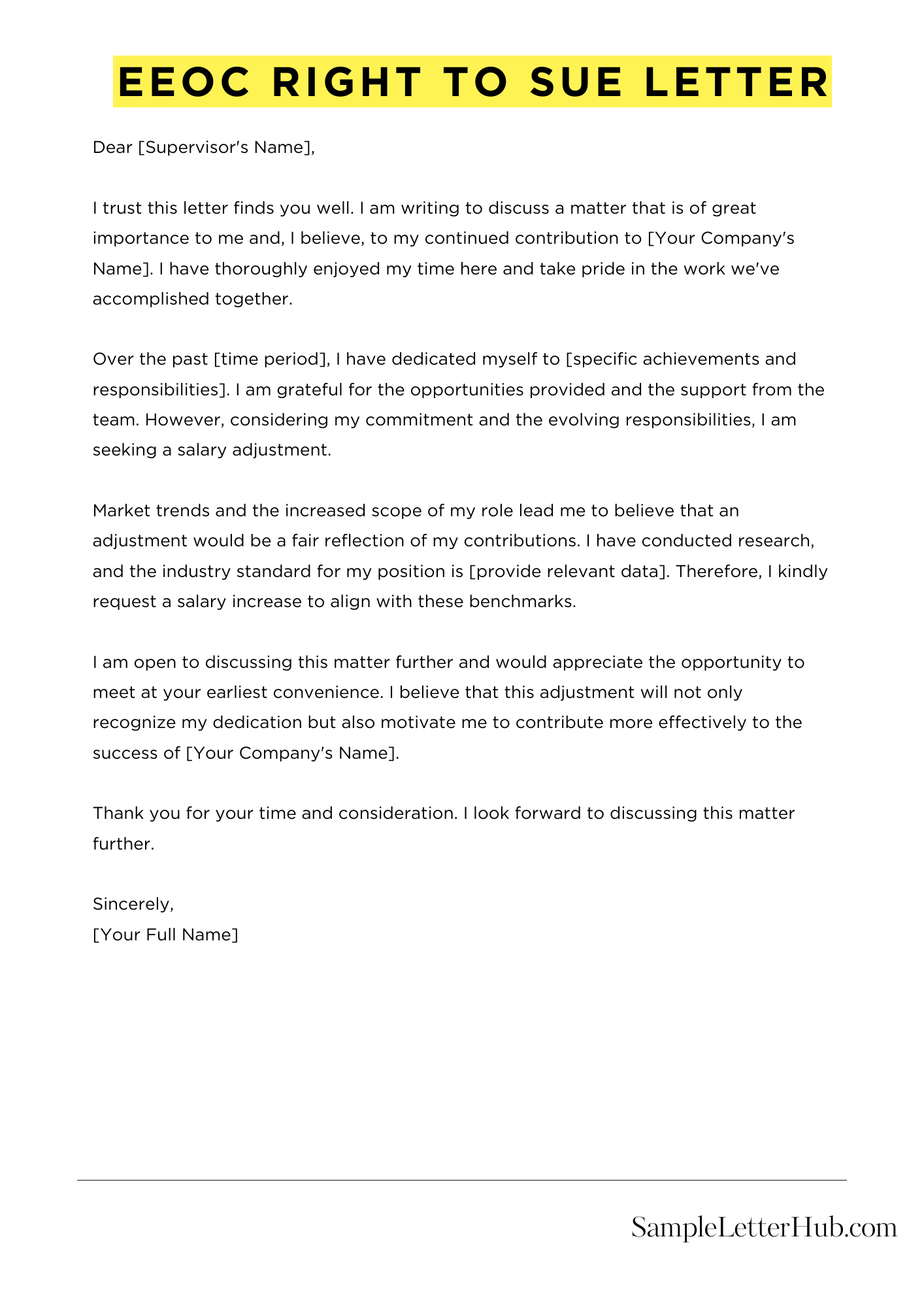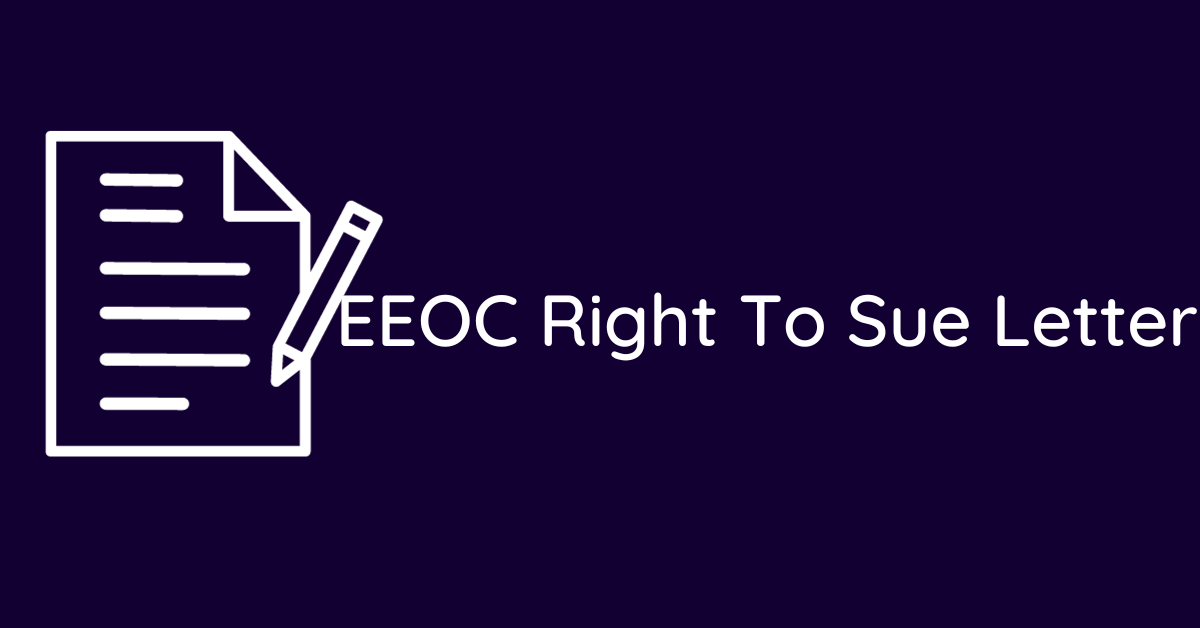The EEOC Right to Sue Letter is a document issued by the Equal Employment Opportunity Commission (EEOC) that grants an individual the right to file a lawsuit against their employer for discrimination or harassment.
This letter is an important step in the legal process and allows the individual to pursue their case in court.
In this blog article, we will provide templates and examples of the EEOC Right to Sue Letter to make it easier for individuals to write their own letter.
These samples will help guide you through the process of writing a clear and concise letter that accurately conveys your situation and intentions.
By using our templates and examples, you can ensure that your letter is professional, effective, and meets all necessary requirements.
Whether you are seeking legal action or simply want to assert your rights, our resources will help you navigate the process with confidence.
EEOC Right To Sue Letter
Dear [Recipient’s Name],
I hope this letter finds you well. I am writing to request the Right-to-Sue Notice regarding my employment discrimination complaint filed with the Equal Employment Opportunity Commission (EEOC).
Details of the case:
Charge Number: [Your EEOC Charge Number]
Date of Filing: [Date of Filing]
Nature of Discrimination: [Briefly describe the discrimination]
I understand that the EEOC has completed its investigation, and I am now entitled to pursue legal action in a court of law. Please provide the Right-to-Sue Notice at your earliest convenience, as my intention is to explore legal remedies promptly.
If there are any additional documents or information required from my end to facilitate this process, please inform me promptly. I appreciate your attention to this matter and look forward to receiving the Right-to-Sue Notice.
Thank you for your assistance in this regard.
Sincerely,
[Your Full Name]
Right To Sue Letter
Dear [Recipient’s Name],
I trust this letter finds you well. I am writing to formally request the Right-to-Sue Notice in connection with my recent discrimination complaint filed with [Organization/Agency].
Details of the case:
Charge Number: [Your Case/Charge Number]
Date of Filing: [Date of Filing]
Nature of Discrimination: [Brief description]
I understand that the investigation process has concluded, and I am now entitled to receive the Right-to-Sue Notice. I kindly request that you provide this notice promptly so that I may proceed accordingly.
If there are any additional steps or documentation required from my side, please do not hesitate to inform me. I appreciate your attention to this matter and look forward to receiving the Right-to-Sue Notice at your earliest convenience.
Thank you for your cooperation.
Sincerely,
[Your Full Name]
Right To Sue Letter California
Dear [Recipient’s Name],
I hope this letter finds you well. I am writing to request the Right-to-Sue Notice in accordance with the California Fair Employment and Housing Act (FEHA).
Details of the case:
Charge Number: [Your Case/Charge Number]
Date of Filing: [Date of Filing]
Nature of Discrimination: [Brief description]
I understand that the investigation process has concluded, and I am entitled to receive the Right-to-Sue Notice. I kindly request that you provide this notice promptly so that I may proceed accordingly.
If there are any additional steps or documentation required from my side, please do not hesitate to inform me. Your cooperation in this matter is highly appreciated.
Thank you for your attention to this request. I look forward to receiving the Right-to-Sue Notice at your earliest convenience.
Sincerely,
[Your Full Name]
EEOC Right To Sue Letter 90 Days
Dear [Recipient’s Name],
I trust this letter finds you well. I am writing to formally request the Right-to-Sue Notice from the Equal Employment Opportunity Commission (EEOC) in connection with the charge of discrimination I filed.
Charge Information:
Charge Number: [Your Charge Number]
Date of Filing: [Date of Filing]
As per the 90-day provision, I am entitled to this notice, and I kindly request it be provided at the earliest convenience to allow me to pursue legal action if necessary.
If there are any additional steps required on my part or if you need further information, please do not hesitate to contact me. I appreciate your prompt attention to this matter.
Thank you for your cooperation. I look forward to receiving the Right-to-Sue Notice within the specified timeframe.
Sincerely,
[Your Full Name]
EEOC Right To Sue Letter Time Limit
Dear [Recipient’s Name],
I hope this letter finds you well. I am writing to request the Right-to-Sue Notice from the Equal Employment Opportunity Commission (EEOC) in connection with my charge of discrimination.
The relevant charge details are as follows:
Charge Number: [Your Charge Number]
Date of Filing: [Date of Filing]
As the 90-day time limit approaches, I am seeking the prompt issuance of the Right-to-Sue Notice. This will enable me to pursue appropriate legal action, if necessary, within the specified timeframe.
I kindly request your cooperation in providing this notice at your earliest convenience. If there are any additional steps required or if you need further information, please feel free to contact me.
Thank you for your attention to this matter, and I appreciate your timely response.
Sincerely,
[Your Full Name]

How to Write an EEOC Right to Sue Letter
If you have experienced discrimination or harassment in the workplace, you may have filed a complaint with the Equal Employment Opportunity Commission (EEOC).
After investigating your claim, the EEOC may issue you a Right to Sue letter, which gives you the right to file a lawsuit against your employer. Here are seven steps to help you write an effective EEOC Right to Sue letter.
1. Understand the Purpose of the Letter
The EEOC Right to Sue letter is a formal document that grants you the right to file a lawsuit against your employer for discrimination or harassment. It is important to understand that this letter does not guarantee that you will win your case, but it does give you the legal right to pursue your claim in court.
2. Review the Letter Carefully
When you receive your EEOC Right to Sue letter, review it carefully to ensure that all of the information is correct. Check the date, your name, and the name of your employer to make sure that they are accurate. If there are any errors, contact the EEOC immediately to have them corrected.
3. Determine Your Deadline
The EEOC Right to Sue letter will include a deadline by which you must file your lawsuit. This deadline is typically 90 days from the date that you receive the letter. It is important to note that if you miss this deadline, you may lose your right to file a lawsuit.
4. Consult with an Attorney
Before you file your lawsuit, it is important to consult with an experienced employment attorney. An attorney can help you understand your legal rights and options, and can advise you on the best course of action to take.
5. Draft Your Complaint
Once you have consulted with an attorney, you can begin drafting your complaint. Your complaint should include a detailed description of the discrimination or harassment that you experienced, as well as any evidence that supports your claim. Be sure to include the names of any witnesses or other individuals who can support your case.
6. File Your Lawsuit
After you have drafted your complaint, you can file your lawsuit in court. Be sure to file your lawsuit before the deadline specified in your EEOC Right to Sue letter. You will need to pay a filing fee, which can vary depending on the court and the nature of your case.
7. Attend Your Court Hearing
After you file your lawsuit, you will need to attend a court hearing.
FAQs About EEOC Right to Sue Letter
1. What is an EEOC Right to Sue Letter?
An EEOC Right to Sue Letter is a document that gives an individual the right to file a lawsuit against their employer for discrimination or harassment. It is issued by the EEOC after they have completed an investigation into the individual’s complaint and determined that there is reasonable cause to believe that discrimination or harassment occurred.
2. How do I get an EEOC Right to Sue Letter?
To get an EEOC Right to Sue Letter, you must first file a complaint with the EEOC. After the EEOC completes their investigation, they will either issue a Right to Sue Letter or file a lawsuit on your behalf.
3. How long do I have to file a lawsuit after receiving an EEOC Right to Sue Letter?
After receiving an EEOC Right to Sue Letter, you typically have 90 days to file a lawsuit against your employer. However, this time frame may vary depending on the specific circumstances of your case.
4. What should I do if I receive an EEOC Right to Sue Letter?
If you receive an EEOC Right to Sue Letter, you should consult with an experienced employment law attorney as soon as possible. They can help you understand your legal rights and options and guide you through the process of filing a lawsuit.
5. Can I still settle my case after receiving an EEOC Right to Sue Letter?
Yes, you can still settle your case after receiving an EEOC Right to Sue Letter. In fact, many cases are settled before they go to trial. Your attorney can help you negotiate a settlement with your employer.
6. What damages can I recover in a lawsuit filed after receiving an EEOC Right to Sue Letter?
If you file a lawsuit after receiving an EEOC Right to Sue Letter, you may be able to recover damages such as lost wages, emotional distress, and punitive damages. The specific damages you can recover will depend on the facts of your case.
Related:

